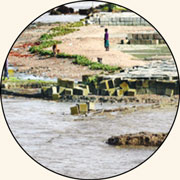 Sea-level rise, the most potentially threatening fallout of climate change, appears to be almost around the corner as studies conducted at home and abroad suggest that what was believed to be a slow-onset disaster is, in reality, not so.
Sea-level rise, the most potentially threatening fallout of climate change, appears to be almost around the corner as studies conducted at home and abroad suggest that what was believed to be a slow-onset disaster is, in reality, not so.
Often referred to as "ground zero for climate change," Bangladesh ranked ninth in the 2023 Global Climate Risk Index, and for many Bangladeshis, particularly the rural communities in low-lying coastal areas, those risks are already unmanageable. Riverbank erosion displaces 50,000 to 200,000 people here each year. The rise of sea levels in coastal areas is prompting people to migrate into cities. Climate migrants are subjected to poor living conditions, contributing to higher levels of poor health, food insecurity, and national poverty.
The recent study by the International Labour Organisation (ILO) has reported that by 2050, some 17 per cent of Bangladesh's territory will be submerged by rising sea levels, resulting in a loss of 30 per cent of its agricultural land. This will compel coastal communities to migrate to cities, where they are likely to be subjected to poor living conditions and unemployment. The ILO's 'Regional Companion Report for Asia and the Pacific of the World Social Protection Report 2024-26: Universal Social Protection for Climate Action and a Just Transition' published last week also highlighted that Asia-Pacific region achieved social protection milestone in 2023 with over half or 53.6 per cent of its population covered by at least one social protection benefit. However, social protection systems in the region face both recurrent and new transformative challenges and require significant strengthening, if these are to effectively mitigate the impacts of climate change on populations in the region.
The report says that despite a rise in social protection, some 2.1 billion people in the Asia-Pacific region remain unprotected against various lifecycle and socio-economic risks, and progress in extending social protection has been uneven. As regards Bangladesh, the ILO Country Director Tuomo Poutiainen said, "As the effects of climate change are increasingly felt in Bangladesh, social protection gains greater importance for building resilience in the face of flooding, heat waves, and other natural disasters." Properly designed and funded effective social protection systems can greatly reduce the adverse impacts of climate change, facilitate just transition, and provide income protection for those impacted, he added.
The impacts of sea-level rise were also assessed through a study titled "Impacts of Projected Sea Level Rise on Water, Agriculture and Infrastructure Sectors of the Coastal Region" conducted by the Department of Environment (DoE) Bangladesh. The study projected the sea-level rise along the coastal belt of Bangladesh for 2030, 2050, 2070, and 2100, and assessed its impact on various sectors. It found that sea level rise induced flooding would cover 12.34 per cent to 17.95 per cent of areas of the coastal zone by 2100. The inundation will affect Bagerhat, Barguna, Barishal, Bhola, Chandpur, Chattogram, Cox's Bazar, Feni, Gopalganj, Jashore, Jhalakathi, Khulna, Laxmipur, Narail, Noakhali, Patuakhali, Pirojpur, Satkhira, and Shariatpur, the study found. The study noted that "In almost all future scenarios, Jhalakathi, Pirojpur, and Barishal will be most inundated, as most of them do not have a comprehensive flood protection system. The areas flooded are mostly inner coastal areas that are not protected by polders or embankments."
The average annual sea-level rise for the Ganges tidal flood plain, the Meghna estuarine flood plain, and the Chattogram coastal plain is found to vary from 3.6mm to 4.5mm, 3.7mm to 4.1mm, and 3.1mm to 3.7mm between 1993 and 2019. "Due to the present rates of local sea-level rise, more than 1 million people may be displaced," the study sated.
The study found that salinity levels will rise further inland. "The higher the sea level rise (SLR), the higher the salinity in the coastal areas. This will affect mostly the south-central region heavily and reduce these regions' agricultural productivity." The study also found that sea-level rise-induced flooding will cause a 5.8 to 9.1 per cent loss in Aman crop production. Barishal, Patuakhali, Jhalakathi, and Pirojpur districts are identified as the most vulnerable and affected areas where most damages will occur. Some coastal regions had been saved from flooding by the existence of polders and embankments.
The study predicted that annual rainfall in coastal regions would be 5.0 per cent to 16 per cent higher between 2050 and 2080. The temperature may increase by 1.4 degrees to 2.7 degrees celsius in the 2080s.The study suggested establishing automated tidal and surge gauges to regularly monitor sea-level rise.
The link between climate change, economic instability, food insecurity, and unmanageable urban migration makes Bangladesh's economy weak and vulnerable that only long-term planning can be expected to address. The country is not prepared for the spillover effects caused by climate change. The lack of resources and ineffective governance will hinder its capacity to respond effectively to climate change. It is high time the government instituted a high level taskforce to chart future course of action. This may also involve interactions with other vulnerable countries in order that exchange of ideas is facilitated in confronting the calamity lurking so close.
wasiahmed.bd@gmail.com
© 2025 - All Rights with The Financial Express
